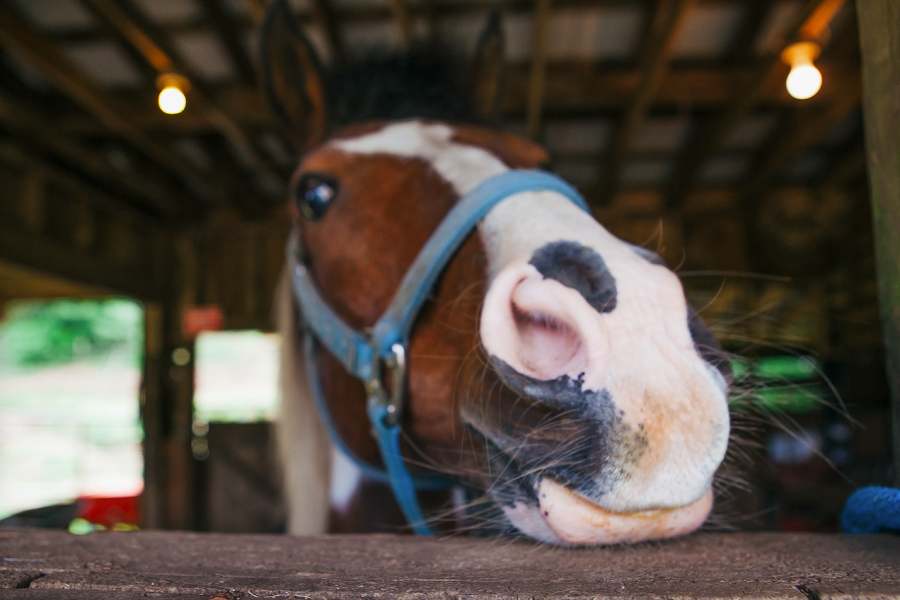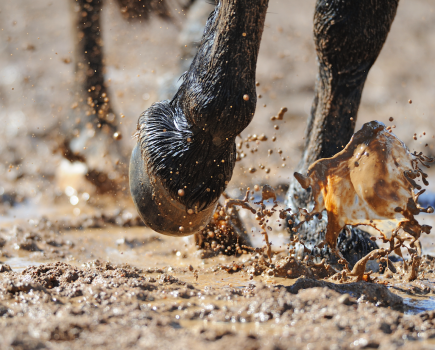Once thought of as a racehorse-only muscle disease, we now know that more equines are at risk of tying up — including those who mainly hack.
Equine exertional rhabdomyolysis (more commonly known as tying up) is a painful muscle disease that affects horse health. You may also hear it called azoturia, setfast or Monday-morning disease.
What is tying up?
Tying up in horses is often characterised by repeated episodes of muscle damage and usually happens during or shortly after exercise.
Affected horses become stiff and painful, often sweat profusely and might be totally unwilling to move. The worst cases become recumbent or might even die.
Tying up/azoturia in horses is described commonly in racing Thoroughbreds and has been best studied in this breed. This is likely to be because the disease affects racing performance.
Several high-profile horses have been affected, such as the 2018 and 2019 Grand National winner Tiger Roll, who was reported to have had an episode as he entered the home straight in the 2018 race.
However, a variety of other breeds are also diagnosed with similar if not identical disorders that might or might not have a common cause.
Tying up is seen in all athletic equine disciplines such as polo, dressage, eventing and endurance riding, and can even occur while out on a hack.
A horse might tie up just once in their life, but some horses are prone to repeated episodes. This is a welfare issue and can become very frustrating for horse owners and their vets.
Signs of tying-up in horses
Tying up is often associated with exercise and tends to occur during or immediately after a horse is worked. The signs of azoturia vary in severity but can include:
- Muscle stiffness or spasms
- Muscles can appear suddenly hard or stiff, or can also start trembling or spasming. This usually occurs in an episode
- High heart or breathing rate
- Sweating
- Horses that are tying-up can suddenly sweat far more than the level of exercise normally causes, and all across the body
- Reluctance to move or recumbency
- A horse might be reluctant to walk, becoming rooted to the spot or stiff during an episode. They might also lie down, which vets refer to as being recumbent, and they might not want to (or be able to) get up
How is urine affected?
In some horses that tie up, the episode is severe enough to result in urine that appears very dark brown or red. This is not caused by blood in the urine, but rather by a substance called myoglobin that is usually found inside the horse’s muscles.
When a horse ties up and the muscle is damaged, the myoglobin is released into the circulation and is removed from the body in urine. Myoglobin at high concentrations in urine can damage the kidneys: on rare occasions this causes kidney failure.
What should I do if my horse ties up?
If you suspect your horse is having an episode of azoturia, you should consider it an emergency and contact your vet. While waiting, try to keep your horse calm. In cold weather, you can keep them warm by putting a rug on.
Often a vet will confirm the diagnosis with a blood sample, and might administer fluids, either via a stomach tube or directly into the vein. A vet can also give your horse painkillers, and in serious cases they might wish to hospitalise your horse for 24-hour care.
In horses that seem susceptible to multiple episodes of tying-up, your vet might recommend a muscle biopsy or other tests to try to get to the bottom of the underlying cause.
Is there a cure?
There is currently no cure for this disorder, although many horses can continue to perform well if managed appropriately in the long term.
There is some evidence in certain breeds that horses with a susceptibility to azoturia actually have improved performance (presumably when the disorder is well controlled).
Aspects of long-term management include diet, exercise, prophylaxis (or administration of a preventative drug) and reducing anxiety.
Diet and temperament
It is advised to maintain horses that tie up on diets that are low in soluble carbohydrate, replacing any required additional calories with fat.
The mechanism by which a higher fat diet benefits horses that tie up remains unclear, but it has been suggested that this could be linked to a calming effect.
Research has shown that horses with a more excitable temperament are more likely to have an episode of azoturia.
This kind of diet would involve replacing calories from high sugar/starch feeds like oats with high fat feeds such as rice bran, or their commercial feed equivalents.
Caloric intake should be reduced in horses that are doing less work because of the season, or because of illness or injury, or due to owner circumstances (such as holidays).
Genetic predisposition
The causes of tying up in horses are varied and not completely understood. A one-off episode can probably sometimes be caused by triggers such as over-exertion or eating something toxic (such as sycamore seeds or seedlings).
However, repeated episodes of tying up after exercise seem to be a syndrome with both genetic and environmental elements. These animals are said to have recurrent exertional rhabdomyolysis syndrome (RER)
Despite this apparent genetic factor to tying up, the only currently identified genetic disorder common in the UK (at the time of writing) is type one polysaccharide storage myopathy (PSSM1), caused by a mutation in an enzyme that is involved in muscle energy metabolism.
However, most horses that tie up in the UK, particularly of certain pleasure horse breeds, do not have this mutation. The gene or genes causing RER have not yet been identified.
Lowering the risk
If your horse is at risk of tying up, the following preventative measures are a good idea:
- A regular exercise programme, with plenty of time to warm up and cool down properly.
- Avoid box rest if you can and ensure a careful return to work after a break.
- Provide plenty of turnout (but avoid lush grazing as part of the dietary management) to help keep your horse active.
- Reduce your horse’s stress levels during exercise, stabling, turnout and during transport.
- Be vigilant when any of these tips are not possible, for example during winter when turnout and exercise are reduced.
Medication options
Studies have shown that dantrolene, a muscle relaxant medication, given before exercise can help prevent episodes of azoturia in some horses that are prone to them.
Depending on the circumstances, your vet might recommend this medication.
Unfortunately, despite the best management some horses will struggle to maintain any kind of athletic career, or they become a constant worry for their owners.
Main image: copyright Shutterstock









